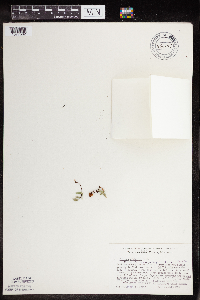Pellaea glabella
|
|
|
|
Family: Pteridaceae
Smooth Cliffbrake, more...dwarf cliffbrake
|
Stems compact, ascending, stout, 5--10 mm diam.; scales uniformly reddish brown, linear-subulate, 0.1--0.3 mm wide, thin, margins sinuous, entire to denticulate. Leaves monomorphic, clustered on stem, 2--40 cm; croziers sparsely villous. Petiole brown, lustrous, rounded adaxially, occasionally with prominent articulation lines near base. Blade linear-oblong to ovate-lanceolate, 1--2-pinnate proximally, 1--8 cm wide; rachis brown throughout, straight, rounded adaxially, nearly glabrous. Pinnae somewhat ascending, decurrent on rachis, usually with 3--7 lobes or ultimate segments; costae when present straight, 1--50 mm, often shorter than ultimate segments. Ultimate segments oblong-lanceolate, 5--20 mm, leathery to herbaceous, glabrous except for occasional hairlike scales abaxially near midrib; margins recurved on fertile segments, covering less than 1/2 abaxial surface, borders whitish, erose-denticulate; apex obtuse. Veins of ultimate segments usually obscure. Sporangia long-stalked, containing 32 or 64 spores, not intermixed with farina-producing glands. Pellaea glabella includes four geographically and genetically isolated taxa treated here as subspecies. D. B. Lellinger (1985) recognized three species in this difficult group, but isozyme analyses (G. J. Gastony 1988) showed that one of these ( P . suksdorfiana ) is an autotetraploid derivative of the diploid known as P . occidentalis . As a result, Gastony recognized just two species: P . glabella (with two varieties) and P . occidentalis (with two subspecies). The few morphologic features that distinguish these taxa, however, are subtle and environmentally plastic, and the isozyme data indicate that they are less divergent genetically than any other pair of Pellaea species in North America. Therefore, a more conservative taxonomic treatment seems warranted.
Perennial fern 2 - 40 cm tall Leaves: several, clustered, stalked, green, thick, sometimes leathery, 5 - 30 cm long, 1 - 8 cm wide, linear-oblong to narrowly egg-shaped or lance-shaped in outline, but one to two times pinnately compound with brown, nearly hairless, straight, central "midrib" (rachis) which is rounded on lower surface. Rhizome: compact, ascending, branched, stout (0.5 - 1 cm diameter), with reddish brown, 0.1 - 0.3 mm wide, linear to awl-shaped, wavy-edged, and thinly textured scales. Leaf stalks: clustered, erect, brown, lustrous, with a few slender scales near base, and rounded on lower surface. Spores: 32 per sac, brown to tan, all of one kind, three-sectioned (trilete), 60 - 72 microns in diameter, somewhat four-angled to rounded, and minutely wrinkled or crested. The spores are released in the summer and early fall, and give rise to the gametophyte (the sexual phase of the plant), which is small, green, inversely heart-shaped to kidney-shaped, hairless, and sits above the ground. Similar species: Pellaea glabella is the only species in this genus in our area, but it could possibly be confused with fertile leaves of Cryptogramma stelleri. However the fertile leaves of C. stelleri have a pale green stalk and central rachis, the final leaf segments are alternate, and usually not all the leaves are fully divided two times rather only pinnately compound once and then only partially divided or just deeply lobed. The sterile leaves of C. stelleri are less similar since the final segments are more rounded or egg-shaped in outline and never toothed. Pellaea glabella is very similar to P. atropurpurea, which occurs more south, west, and northeast of the Chicago Region, but that species has long-silky hairs along the lower surface of the pinnule midribs; the underside of the rachis is dense with short, curly, appressed hairs; and the largest pinnules (but not including the terminal pinnules) are usually over 3 cm long. In our area, we only have the typical subspecies of P. glabella (as described above), but further west there are two other subspecies, P. glabella ssp. simplex and P. glabella ssp. occidentalis, which differ by having hairless pinnules. The third subspecies, P. glabella ssp. missouriensis, occurs in the Ozark region of Missouri and differs from the typical subspecies by having 64 spores per sporangium, and the spores are only 38 - 52 microns in diameter. Habitat and ecology: Very rare, requiring calcareous (limestone or dolomite) rock faces, cliffs, or bedrock outcrops. Occurence in the Chicago region: native Notes: Species of Pellaea are adapted to dry conditions. The typical subspecies of P. glabella was apparently derived from the very restricted subspecies P. glabella ssp. missouriensis from the Ozark region of Missouri (Windham 1993). Author: The Field Museum Common Name: smooth cliffbrake Etymology: Pellaea is from the Greek pellaios, dark, alluding to the stalk, Similar to P. atropurpurea, but with monomorphic lvs mostly 10-20 cm, the pinnae somewhat decurrent, gradually departing at acute angles to the rachis; basal pinnae with 3-7 segments, less than twice as long as the upper; longest ultimate segments mostly 1-2 cm; petiole and rachis glabrous or slightly hairy; scales of the rhizome discrete, uniformly rust- brown, lustrous, the tips not entangled; margins of the fertile segments usually strongly reflexed, leaving but few sporangia exposed; ours mostly tetraploid (2n=116) and apogamous, the sporangia with 32 spores. Calcareous cliffs or bluffs; Vt. to Va. and Tenn., w. to Minn., Kans., and Tex., and in the western cordillera. Our pls are var. glabella. (P. atropurpurea var. bushii) Gleason, Henry A. & Cronquist, Arthur J. 1991. Manual of vascular plants of northeastern United States and adjacent Canada. lxxv + 910 pp. ©The New York Botanical Garden. All rights reserved. Used by permission. |
|
|
|


























































































